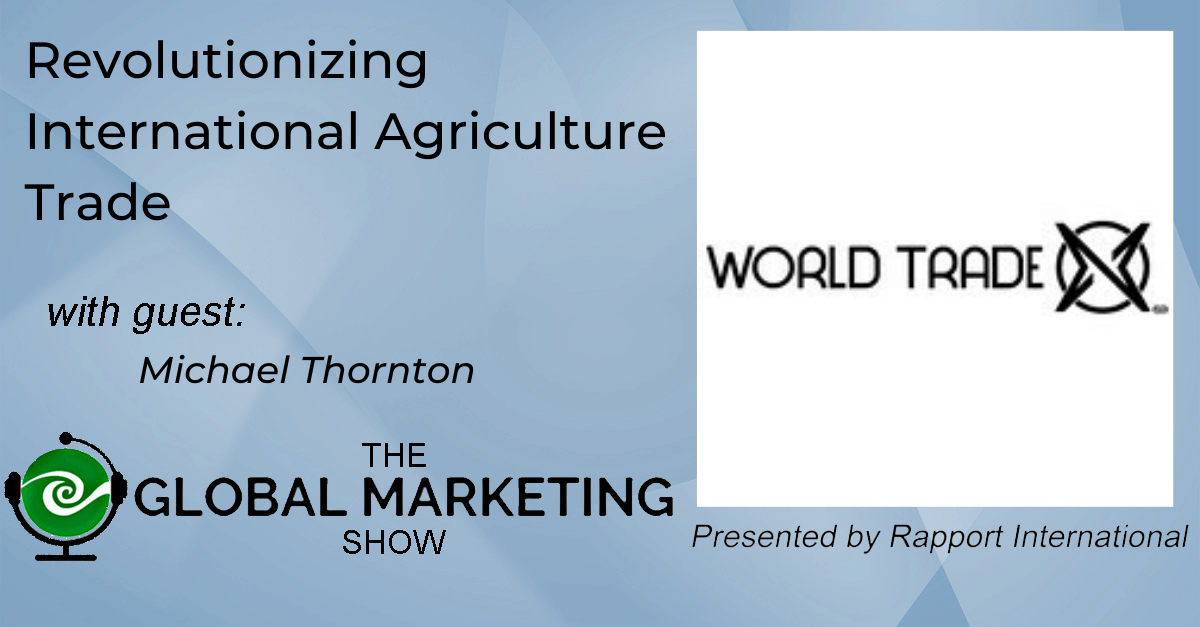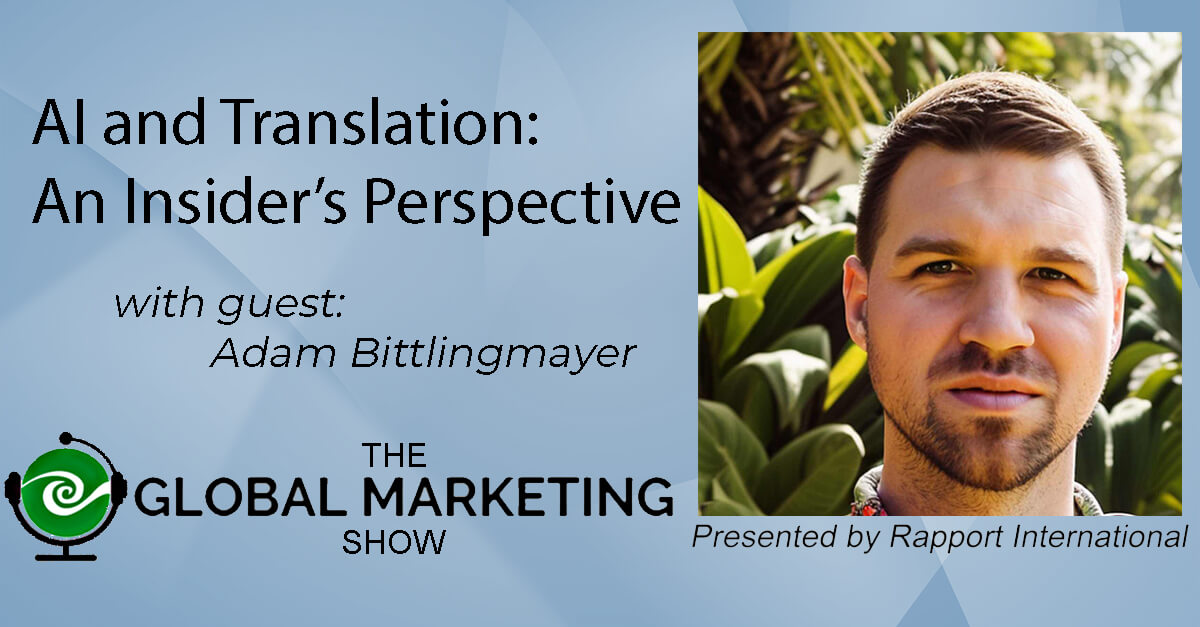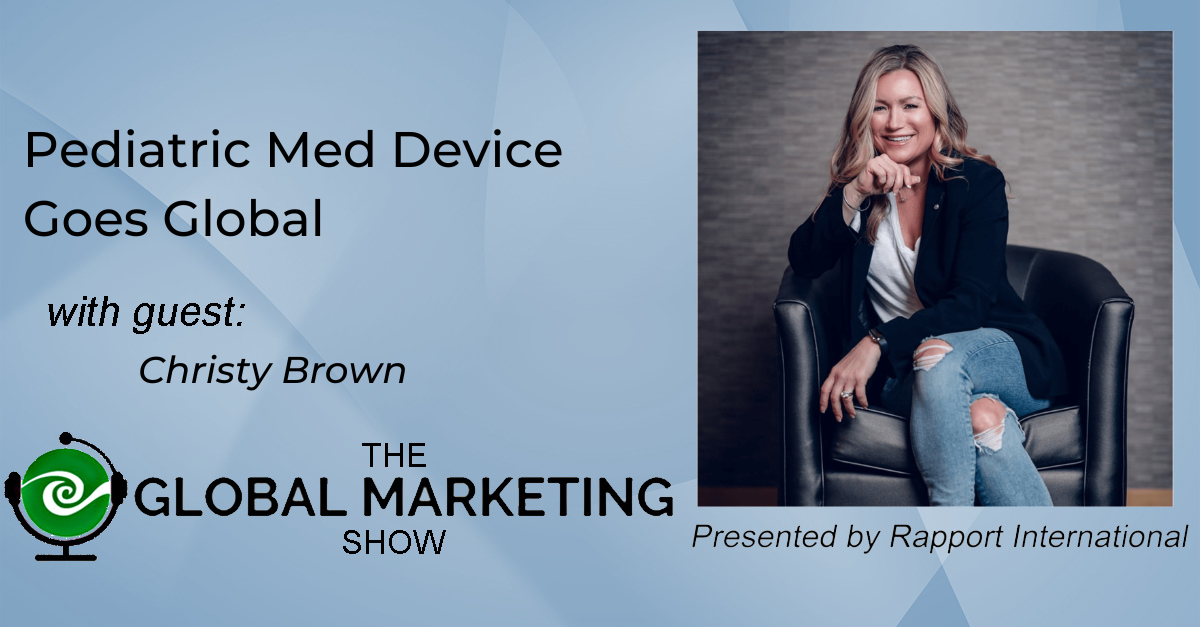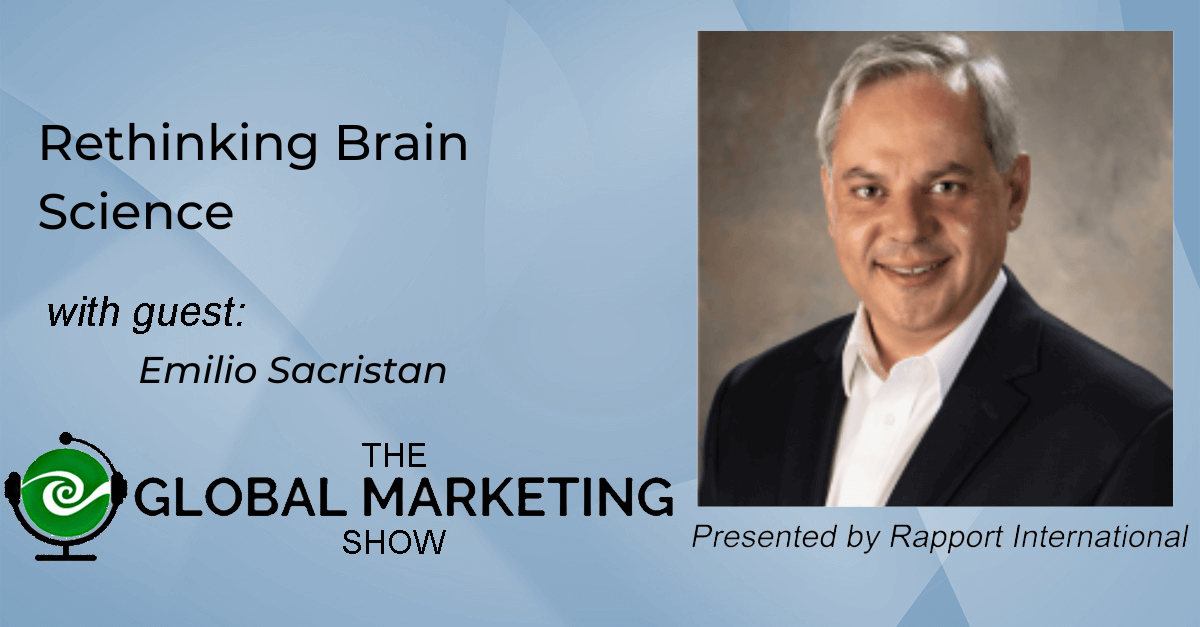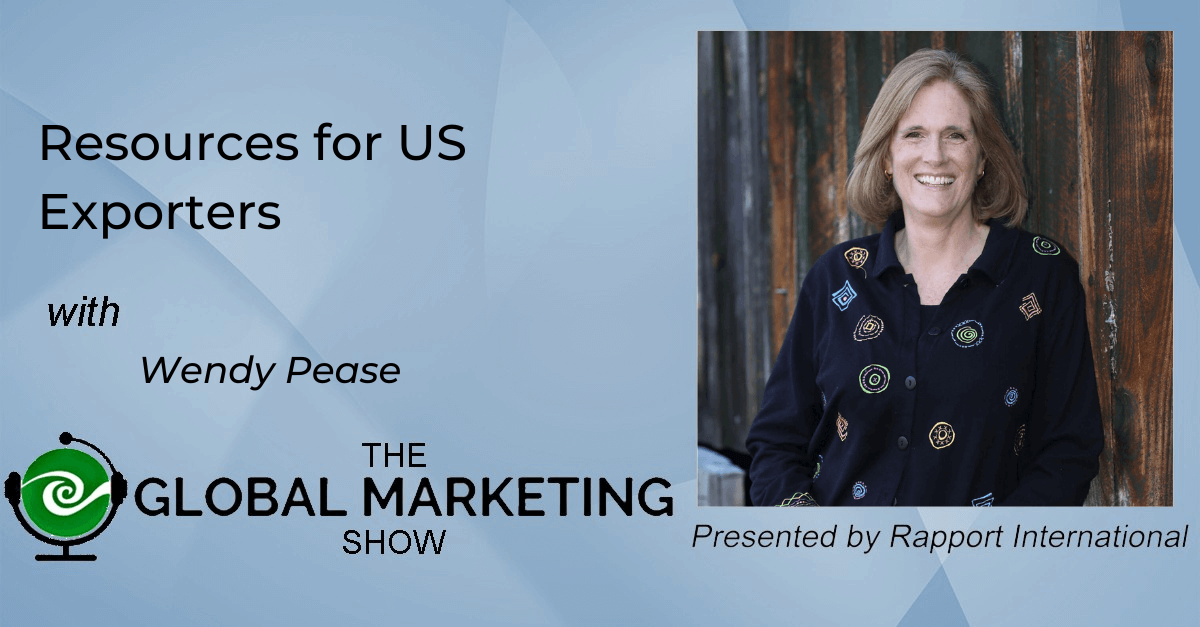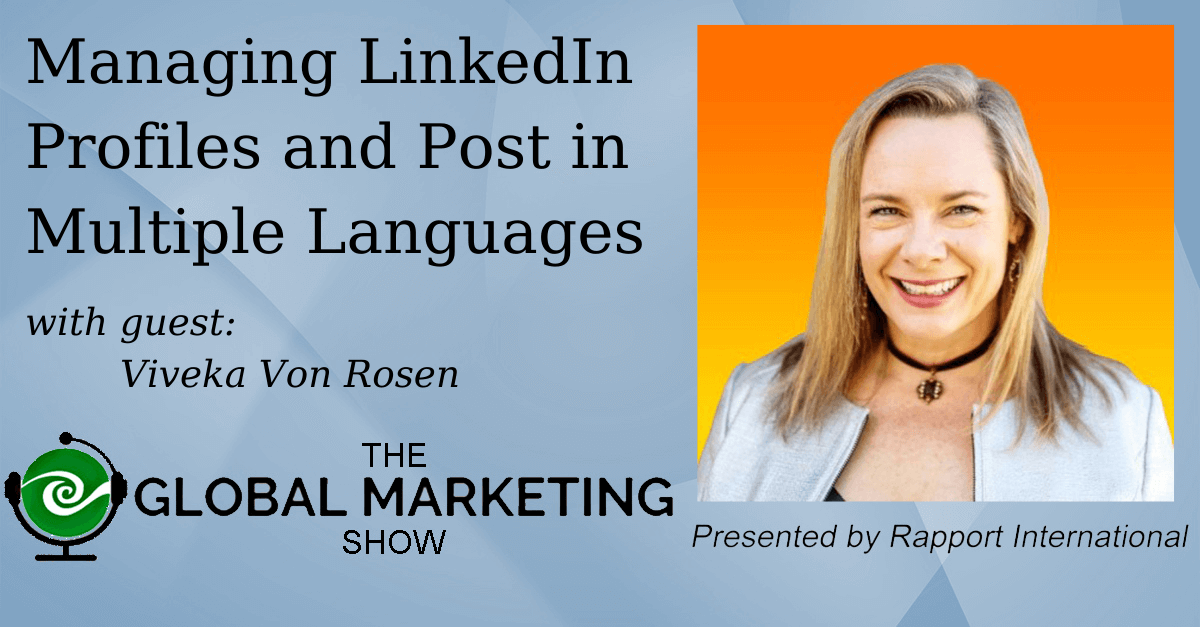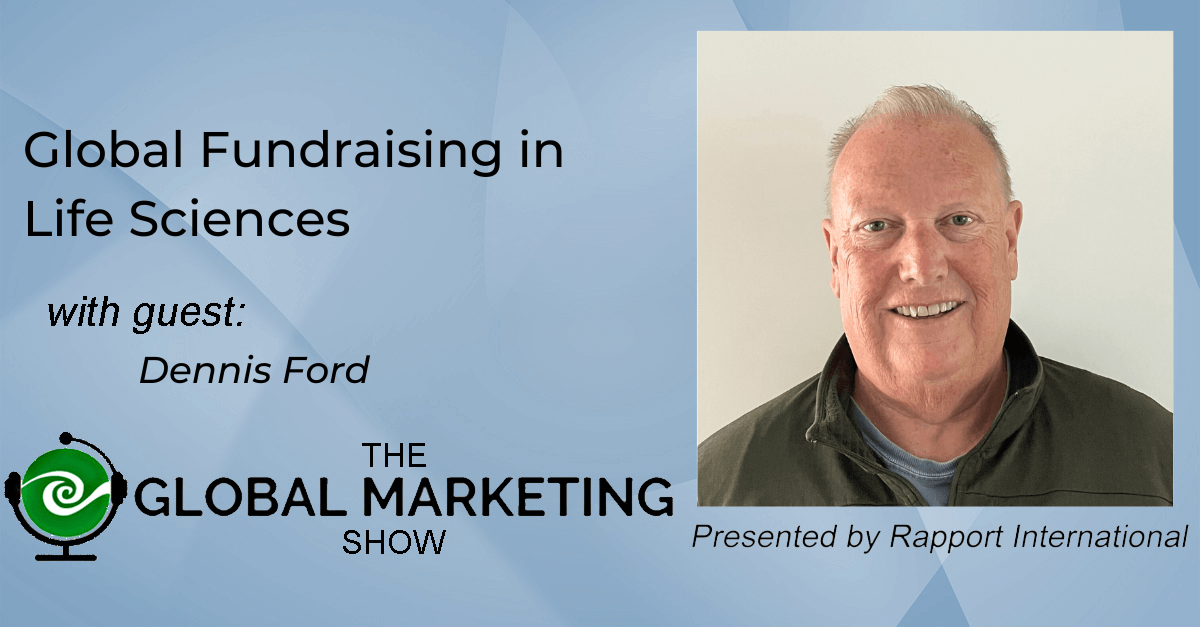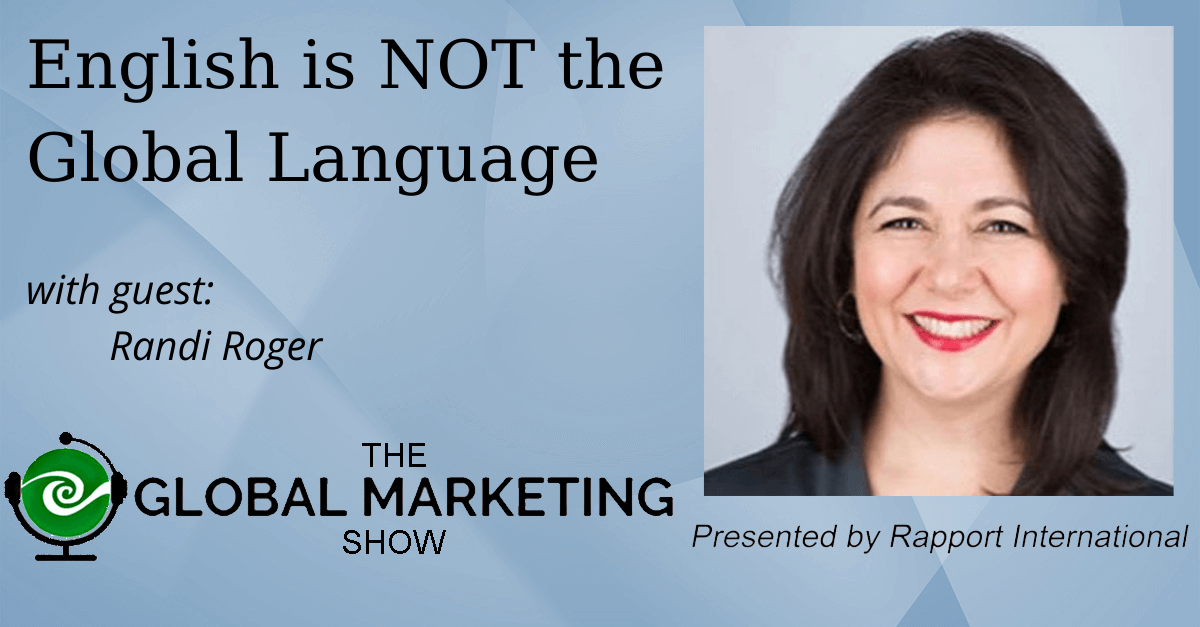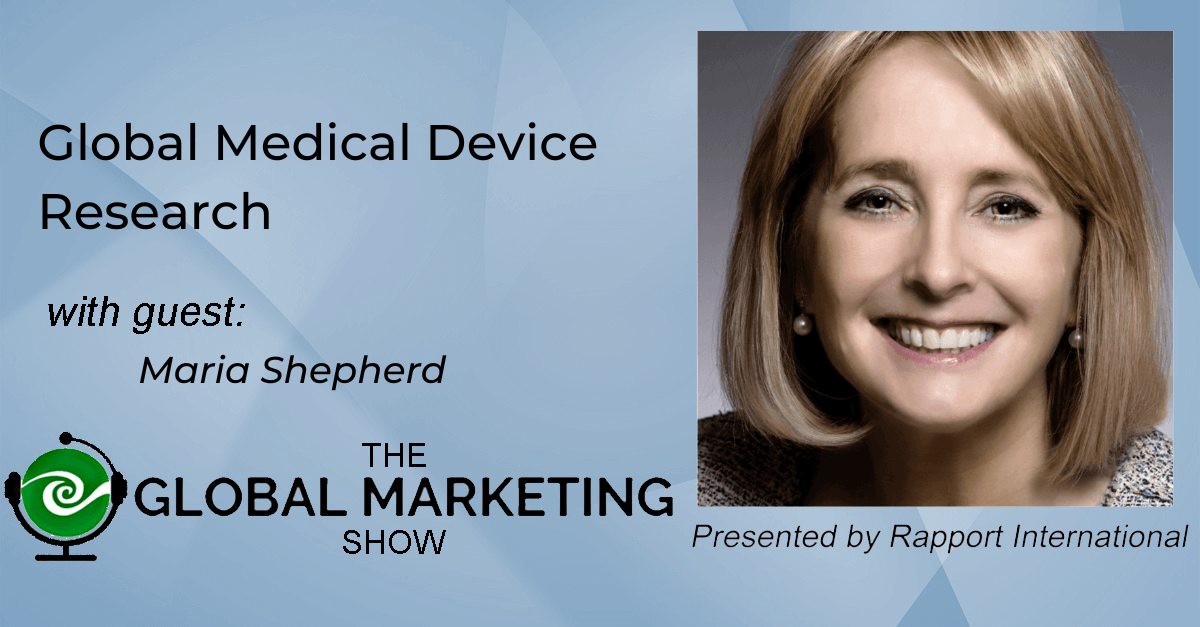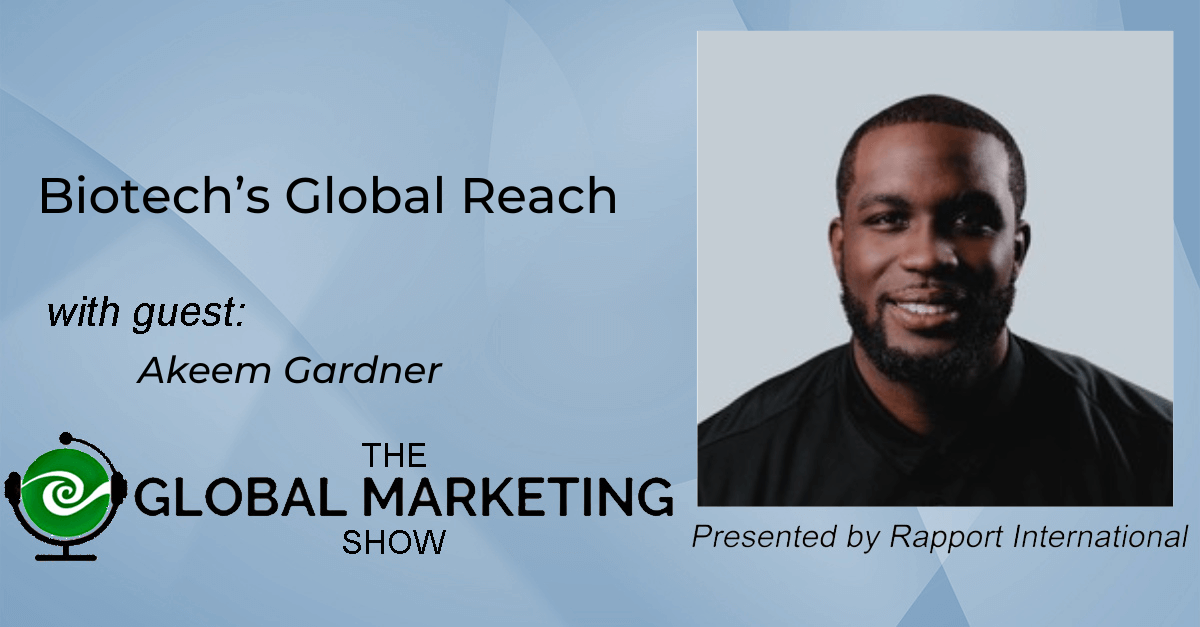Chris Curtin has had an incredible career in marketing for Disney, HP, and Visa.
In this episode, he explains how good marketers have to start with having a good sense of self and how they take the complex and make it simple.
With this understanding they can focus on making the future brighter than the past.
We discuss some marketing missteps that Disney made and how they adjusted for success. And, how they handle localization and translation.
And he gives fantastic examples about Visa welcoming visitors, Ray-ban Sunglasses building sales through affiliation, and Alibaba recognizing the importance of red envelopes.
Links:
Relevant articles about Chris:
https://www.digitaltrends.com/wearables/visa-payment-ring-rio-2016/
https://www.cnbc.com/2017/03/13/visa-pay-with-sunglasses.html
https://www.sportsbusinessjournal.com/SB-Blogs/Breaking-News/2020/06/Chris-Curtin.aspx
LinkedIn: https://www.linkedin.com/in/christophercurtin/
Connect with Wendy: https://www.linkedin.com/in/wendypease/
Music: Fiddle-De-Dee by Shane Ivers - https://www.silvermansound.com
ATTENTION: Below is a machine generated transcription of the podcast. Yes, at Rapport International, we talk a lot about how machine translation is not good quality. Here you see an example of what a machine can do in your own your language. This transcription is provided as a gist and to give time indicators to find a topic of interest.
[00:00:34] Wendy: I global listeners, you know, we're downloaded in 55 different countries now on the global marketing show podcast. It's so exciting to see the reach that we've gotten. And we talk a lot about here about global expansion, global business, global marketing, but you might have more particular questions and our sponsor is Rapport International.
[00:00:58] And I don't think I've ever mentioned that there's a great learning center there. If you go to Rapport, R a P P O R T translations.com and look for the learning center on there, you can search and you can get videos and white papers and pillar pages and audio, all sorts of things about any topic that you want to do with global marketing and your industry.
[00:01:23] So that's a good resource for you that I thought I'd mentioned today. So I really want to get into introducing our guest. Chris Curtin. Do you prefer Christopher or Chris? Cause I see on we're talking on a zoom call. I said it says Christopher, but I always call you Chris.
[00:01:42] Chris: Let's go, Chris, if I'm not in trouble.
[00:01:47] Wendy: Know, you're not in trouble here. We're very excited to talk to you. So a little bit about Chris, Chris Curtin is his name C U R T I N. You can find him on LinkedIn. He's a senior executive with C-suite experience and performance-based marketing strategy, business management, innovation, operations, and communications.
[00:02:11] Now hold onto your seat. When you hear where he's worked, because SCOBY really interesting. He's worked at visa Disney and HP, and through all those experiences, he's become a thought leader on brands, digital transformation, and high impact leadership. So I am so excited to have you here today, Chris.
[00:02:33] Chris: I'm excited to be here.
[00:02:34] Thanks for having me. Yeah.
[00:02:37] Wendy: So tell me, give me a, the low down on the three different companies. What was it like to work? Like what would you describe the culture, the differences and the similarities of working at each of the companies?
[00:02:51] Chris: Well, , I think, , on their surface, it's always easy to find the differences.
[00:02:56] , there are different categories of the economy and marketplace they're of different sizes. They all have uh, a different kind of founding history to. And , they have different challenges ahead of them. Some of them are created by the marketplace. Some of them are created, are unique to the category and some of them can even emerge from within.
[00:03:17] But I think all of that kind of mask how similar they can be. In fact how similar they are. And I, and I think, , one, one element which is really important for all companies, but, but, but it was pronounced at all. Three of those is to ensure that the future is brighter than their past. And it's very easy.
[00:03:34] It's very tempting for companies to kind of become naturally museums, particularly companies that are big, particularly companies that have been around a long time. And you start kind of looking backwards and you start relying upon the core business. To be in the future, what they've been in the past.
[00:03:52] And I, and I think that's a huge mistake. I think part of, part of the responsibility of management is to architect, , businesses and brands to be able to succeed in future marketplaces, not just today's and certainly not yesterday's and they're all dynamic marketplaces. And and I think that tension was palpable at each of the companies and the people who kind of emerged, , beyond being just managers of what they oversold to be leaders of what they ever saw were the ones who were much more kind of future focused future bed, future.
[00:04:27] Wendy: Give me an example of that, like a manager at one of the companies who did a really good job, like take us into a situation.
[00:04:36] Chris: Well, I mean, you know, whether it's Disney and, , thinking about the destination businesses, I think there was certainly a view at one point that , you would come to a theme park and you would, you would have a, uh, Disney experience in that respect and you would come episodically to the theme park.
[00:04:52] Maybe if it was Walt Disney world, it was every other year. And maybe if it was Disneyland, which is much more of a drive market, it was seasonally. And I think the notion of sitting back saying, , that's one way for the Walt Disney company to come to life physically, but they're all their ways, including the cruise ships and included, guided toward businesses and including timeshare that they're those that, that increase in expense.
[00:05:15] The portfolio of offerings and the destination businesses without ever diluting some of the core properties and, , there's always a debate, , when you offer something new, particularly if it's an adjacency, is that going to draw down upon the business that you already have secured, or you think you already have secured?
[00:05:35] And, , I, I, that's something that companies have to kind of get over and get past and not view the world or the market demand as zero-sum easier said than done. But you know, the best companies in the world are the ones who believe, , that their, that their platform can expand.
[00:05:52] Wendy: That's a really great point because you see that a lot with entrepreneurs, I've gotten to the side and I'm proud of how I've done, but you can't maintain, you're either growing or you're shrinking. So if you're a large company, you're still thinking you've still got to be thinking that way.
[00:06:08] Chris: Yeah. And there were great examples just in the one that I offered where, the line got very close and some people said, , I don't want to choose between, uh, a cruise and a couple of nights at Walt Disney world, I think Disney in a very kind of intelligent and sophisticated way, create a, created a bundle out of the two.
[00:06:25] So you could spend half your Disney vacation at Walt Disney world and then the other one. Going to port Canaveral and then ultimately taking a cruise. And so , you kind of walk towards that conflict and solve the conflict as opposed to avoid it and hope it resolves itself. And I think that kind of instinct plays itself forward, including in FinTech, where I think most of FinTech is focused on trying to find friction and trying to remove friction.
[00:06:51] And, um, again, , Meg, Whitman always said, which I thought was, was a very apt statement that, , problems don't age well and challenges don't age well. And so the, the, the more kind of preemptive and head-on, you can be about them, , the better it is for your business.
[00:07:08] Wendy: So how about at Disney?
[00:07:09] Like they did a really good job with the destination and then offering the bundle. I remember hearing about some stumbles when they opened in France. Was there any, you know, do you know more about that I've vague memories of them or were there other stumbles that you saw with expansion in, in what were they, what caused them and how did, how did they solve them?
[00:07:34] Chris: Yeah, I mean Francoise Mitterrand may have called , Euro Disney at the time, a cultural Chernobyl. So then there were, there were, there were hiccups along the way, but , I think with hindsight being 2020, what an incredible decision to place it in March. And I think the two destinations that were under consideration were Spain and France.
[00:07:56] And, , you just, it, it, I believe that decision has changed the trajectory of, of continental Europe. You know, the channel was extended from London to, uh, all the way to not just Paris, but also ultimately to Marla valley. And so there's kind of a connection point between the UK and France and, and Euro Disney in that respect.
[00:08:15] I think it's Disneyland Paris now that it was the number one tourist attraction in Europe, above, above the Vatican above London. I think it's an incredible , blueprint for wherever Disney plants, its flag physically the other parts of the company and up flourishing it becomes, , a, a mechanism through which all of the franchises, the company.
[00:08:36] Can come to life through in 65 days a year and delight audiences. And I'm not even talking about the marketing of the property, but just the experience of the property when you get there. So you know, it's rare to have founded a decision that Disney has made in the, in the context of, I think the destination businesses that over the course of time hasn't penciled out to the benefit of the company and hasn't been penciled out to the benefit of the host market and region.
[00:09:02] There were also things that, that I think Disney did that ultimately kind of address some of the concerns, um, Uh, embrace of the artists community and the creative community , with respect to the property and France that I think was a little bit of concern , from, from, from the French, I think second, there were traditions that were typically French, including selling wine that, that, that Disney, uh, ultimately would accommodate.
[00:09:28] And so that the property felt indigenous to the country that hosted it. And I think, uh, that was to the benefit of all.
[00:09:35] Wendy: Oh, so that's interesting. So what I remember hearing was really kind of this backlash and push, because it was a cultural Chernobyl, like you can't bring this Americanism Disney into France, but that was just the initial push of change or unaccepting, but ultimately it thrives and it, because of the biggest tourist destination,
[00:09:59] Chris: Yeah.
[00:10:00] And I also think that while Disney may be a us flag company, I think Disney is a global concept, spins a global property. And it's something that, , it entertains and delights the children of France, as much as it entertains and delights and captures the imagination of the children of the United States or, or of Spain or Mexico or China or Japan.
[00:10:21] So, you know, I think at the end of the day , that's, that's been one of the ingredients that ultimately has been behind the success of Disney, but also the success of Disneyland Paris in Europe
[00:10:32] Wendy: more about that, because that's what I hear with companies that are global. They say you've got to find something that people rally around and Disney entertains and delights children worldwide. Did they S they didn't start with the plan to go international, but they had something that could relate across to everyone.
[00:10:58] Right. Is that what you're saying?
[00:11:00] Chris: Yeah, I think, I think they, uh, does he dealt with, with concepts that were inherently global, long before they were ever an international company. And so they're dealing with concepts Storytime that's global, that's borderless that's ageless. That speaks to all of us.
[00:11:18] I mean, I think it, the notion was it wasn't just some something aimed at children. It was aimed at the child within all of us. And sometimes by, by definition of age, the child is mostly us. But as you get older, it's a, it's a component of us. And, , I don't know that it ever goes away. And I think that's what makes it such.
[00:11:38] Kind of universally appealing , uh, property and brand and ultimately experience. I mean, , the, whether it's in Tokyo, which I think is one of the most commercially successful properties in the world, or you seem what Disney has done in Hong Kong, as well as in, in Shanghai, you know, even where it kind of misses a beat, it takes stock of that.
[00:12:00] And perfects that and ends up, , kind of what the flagship expression of the company and in those different regions and to the, to the credit of the company.
[00:12:10] Wendy: Okay. So you mentioned that I want to dig down into that a little bit more. So the company has something that's inherently global.
[00:12:16] They expand to France. Well, in the United States, you can't get alcohol on the Disney properties, right? You don't walk around drinking wine or beer or anything.
[00:12:26] Chris: Well, I think it was at the magic kingdom at the time. Uh, you know, this is when I was there, but, uh, at the magic kingdom, the magic kingdom was intended to be main street or replicate main street in a specific period of time.
[00:12:40] And I think at the time it, it did not serve alcohol. There are other places within Disney that did Epcot being an example. But, but when they replicated main street in more in low valley, in the first instance, they did not serve wine and or alcohol, but they revise that policy because I think at the end of the day, they felt like, you know, this is on French soil, it's a French custom and French behavior.
[00:13:08] And it celebrates the proud history of the French, particularly with respect to, to wine and the making of it. So, , I think, I think that's a great example of the company kind of maturing and evolving to adopt and cooperate with, with local customs and, and tradition.
[00:13:28] Wendy: Expand upon that more.
[00:13:29] Cause that's exactly what you said. They, they miss a beat, they fix it and then they expand to be flagship. We're very successful. I forget exactly how you said it, but I thought that was a really good point that you've got a company that's inherently global and then across all these different countries, you'd have to adjust and fix.
[00:13:47] Can you give us other examples of that?
[00:13:50] Chris: Yeah. I mean, I think in one instance, I don't think it's schizophrenia at all. I think, , we are all, both human and in our, in my instance, American, so you can be both and both can and cohabitate and, uh, you know, I think that's the kind of balance that Disney is looking for is like, what are the components of storytelling?
[00:14:10] What are the components of experiences that are effectively borderless? And then also what are elements of each region in each nation? And that people should rightly have pride in and, and experience. And that's the beauty in some instances of travel, , when you leave the United States and go to a foreign land and you have that experience, part of what, , kind of revives the soul within all of us is that that experience is just different and it may not be better and it may not be worse, but it's just different than, than your home countries.
[00:14:42] And so I think getting that balance, , right where it's a, it's a universal Disney experience, but it also pays homage to the different markets in which it's located is, is part of the magic of the company.
[00:14:55] Wendy: Okay. So there's, there's wine in France. You go to Tokyo and granted the signs are all going to be different.
[00:15:02] They're all going to be in the native country language. So that's going to look very different. What else would you experience that was different in total?
[00:15:10] Chris: Well, I think each of the properties, , and speaks to the host nation in a way that you would feel like it there's a Japanese component to to Tokyo Disneyland and the same thing for Hong Kong in the same thing for Shanghai.
[00:15:26] The company would be better suited to, to explain the nuances of each of those properties and where they're tipping their head and chipping their hat to those traditions. And I would, but I know that's part of the, part of the planning and part of the creativity behind them. Who did,
[00:15:42] Wendy: who does that like, is it a global Hulu, like there's gotta be a global organization, but then who decides on the cultural adaptation, do they do it in?
[00:15:51] So what I'm trying to get at now is there's global companies that really. Look at the globe and then how they manage it is more of a centralized. And then they have a multinational where they may land in a country. They hire a management team, they give them the resource and then they say, okay, go give it to the company.
[00:16:11] So there's a natural conflict with Disney because that brand is very well protected yet they're trying to accommodate. So do you, can you tell us how that played out?
[00:16:23] Chris: Well, I think they have, in some instances, kind of a set play on, on one third being, this is the Disney experience. One third being, these are the lessons learned from instances such as your, a Disney, which we just kind of discussed.
[00:16:39] And then one-third , you're importing Disney into a host country. And here, here are the things that, , you really want to get, right. Well, beyond. Localization and, and translation. And by the way, , localization translation, isn't easy because , someone, someone might sit back and say, well, what's difficult about it.
[00:16:58] You have to do Mandarin and English or Cantonese, Mandarin, and English. And the truth of it is, , for most of those properties, they are still international destination. So while hosted in France, you've got multiple languages coming into to France, same thing for Hong Kong. And same thing for frankly, the same thing for Anaheim and, and Orlando you know, Orlando pre pandemic.
[00:17:23] I'm not sure what the numbers are now used to, , enjoy tons of, of travel from, in tourism, from places like Brazil, which would of course speak, speak Portuguese. And so you had to be able to accommodate all of that, to ensure that the experience lived up to expectations.
[00:17:39] Wendy: So, is there a set number of languages that Disney translates into, or is that, could that vary?
[00:17:47] Do they have identified languages?
[00:17:50] Chris: Uh, you know, I don't know what the, what the, the number of languages is right now. I do know that, , for instance with companies like visa, we were in 200 markets. So, , in same thing for HP, I was responsible for hp.com and, , we had to find probably one of the world's best pieces of software that could ultimately in dynamically put every single skew that the company offered.
[00:18:18] And so the right language in the right market and before the right kind of browser. So that, that sounds easy. It's actually not particularly in the context of headless headless commerce.
[00:18:29] Wendy: Wait a minute. That's a term I haven't heard before. What is headless commerce?
[00:18:35] Chris: Well, I think, , originally when the, when the internet was designed in, in some instances, particularly from a commercial standpoint, it intentionally or unintentionally, and there's great debates about that replicated the world of physical commerce, specifically brick and mortar commerce, so that, , when you go into a brick and mortar store , there's a front door and you're greeted.
[00:19:00] And so what the internet did was like, okay, well, w w we'll have a front door it's called a homepage and you will greet you we'll use it. We'll use kind of a a main page, , our main tile on that homepage as, as a form of greeting, until we fully understand that. What brought you to our store.
[00:19:18] And so each kind of beat of the physical store experience was in some instances replicated into the digital flow and the digital experience online. And I think as we've gone along, we've realized, wait a minute. , that's not always going to be the way people interact with brands digitally, and maybe the brands find them where they are as opposed to the browser, , types into a URL.
[00:19:49] This is the brand that I want to find and go just goes to the experience. So there's floating it. Commercial experiences that are branded there are ex. Commercial experiences that are branded, there are targeted experiences that, that are branded. So that headless kind of environment is where kind of, I think the best brains in Silicon valley are now thinking about the future of commerce and thinking about how you kind of intercept demands and go to demand, not just pull demand to you.
[00:20:20] Wendy: Okay. Say radically. That makes sense to me because how you go into a store brick and mortar is very different than how you shop online. So what, what, what did talk to me more about that? I wanted to hear more. That's why there was a pause floating, exported targeted, and you don't just pull. I mean, you in marketing terms, there's the push and the pole where you're trying to push and you're advertising and you're trying to get people's attention.
[00:20:51] Paul means you've put something out there and you're trying to pull them into you when the floating, they exported in the targets, all be trying to pull in.
[00:20:59] Chris: Yeah. So I think part of it is, , in addition to, so these aren't replacements, thug, these are in compliment of it destination. So you have a destination digitally and, , to the extent that there's traffic that ultimately wants to have that experience, that's an understood well-defined.
[00:21:18] Well-architected experience. But to the extent that there's a lot of demand, which I would argue is the vast majority of demand that is above and beyond those clicks that are coming to your site, what's the smartest best way to kind of interact with them. And I think in the past, , many of us would have said, well, advertising, like I want to go, I want to get in front of Wendy as she is on the worldwide web.
[00:21:44] And tell her about my brand, tell her about my company and tell her to come to me, tell her to stop what she's doing and redirect herself to my site. And I think, I think the best thinking now digitally is like, look, that's not the only way. So let, let's try to find her where she is. Not interrupt that experience, but instead put before her something that we think would be relevant or compelling, that is in some instances, kind of a shoppable unit, it has, it has everything that you would need that now is effectively one click away.
[00:22:18] So for instance, you're looking at your Ray ban. This is a bad example, but hopefully it's it's, it explains the point. You're Ray ban and someone is looking for a spring break trip to the Caribbean rather than like getting into a place where you have to pull them out of booking the accommodations, booking the airfare, booking all the other elements, how does Ray-Ban finding its way into the shopping.
[00:22:44] That Expedia otherwise is, is, is putting, pulling together for that vacation and for that trip, as opposed to having you stop purchasing that trip, to come to Ray-Ban, to buy sunglasses. In addition to all those things, I think the best people in e-commerce are sitting back saying, yeah, we want to be part of that buying experience for the spring break trip to the Caribbean.
[00:23:08] We don't want to compete with it. We don't want to fight with it, but we would love to enrich it. And we'd like to be a component of it.
[00:23:14] Wendy: Yes. That makes absolute sense to me because it just, you know, I'm thinking of, I gotta get my tickets and I got to do my packing list. Oh. If I could do my packing list and I just check off, oh yeah, I want new sunglasses.
[00:23:25] I want new luggage and I want new a new bathing suit and they could automatically come in and arrive, ready to go for the trip. It saved me time and hassle. Right.
[00:23:35] Chris: Makes sense. Yeah. And I think it's it's, that is kind of an offensive play. And, and I don't think it ultimately dilutes from the people who would go to Ray-Ban on a standalone basis.
[00:23:49] And I think, I think, , you, if you listen to the companies like Shopify as an example, this is, this is the way they think, and this is this in the stripes of the world. This is the way they think, and this is where they're going. Um, you know, they, they, they follow the Wayne Gretzky, , go to where the puck is going.
[00:24:08] Philosophy.
[00:24:12] Wendy: How does that adapt over to the global marketplace
[00:24:16] Chris: from a geography perspective or from, from whatever.
[00:24:20] Wendy: Emotional demographic, geographic. I mean, we already know that people buy differently. They shop differently. They want things in their own language. , and depending on the culture.
[00:24:33] Chris: Yeah, I look, I think, I think, I think one thing that's really important and it, it, it plays itself out within the United States, but it also plays itself out beyond the United States is innovation.
[00:24:48] Doesn't come from a certain zip code. Silicon valley does not have a monopoly on, on, on innovation. In fact, , whether it's Miami, , kind of trying to become now renowned for cryptocurrency or whether it's Austin and what I think Austin is trying to develop from a FinTech perspective.
[00:25:06] You know, I think, you know, or even Detroit and what Ford and others are doing with electrifying transportation, the, the notion that , innovation again, it's a borderless it's a borderless opportunity and it shouldn't be housed in one zip code within the United States. And it's certainly true about, you know, uh, with the same concept is true beyond the United States.
[00:25:28] I know for instance, many times, , we would look to. Alibaba and to 10 cent and to QQ , to, as, as points of inspiration, I mean, Alibaba, uh, as just one example created, , commercial holidays that are like five X, six X, seven X, the size of cyber Monday. And I think the notion of how you create experiences that reward the consumer and capture their attention and imagination.
[00:25:59] You should constantly be looking for the great idea, wherever it originates.
[00:26:04] Wendy: That's interesting. I hadn't heard about Alibaba and the commercial holiday of what, what did they create there? It wasn't cyber Monday. It was something.
[00:26:14] Chris: I think it's called red envelope day. And it was about, it started with, , different colleagues in the workplace who would do something special for you.
[00:26:23] And they would give it to you in this type of envelope as a form of recognition for all that you've done. And I think Alibaba, , said, wait a minute, that that could basically be a version or, you know, their version of cyber Monday where special things are given to you or you have special access to, to products or solutions.
[00:26:46] , and we're, we're going to reward that and recognize it and organize it around a specific commercial holiday that had historically never existed.
[00:26:54] Wendy: That's so interesting. Yeah. And the Chinese new year, it's been tradition to give a red envelope with cash in it, to the children when they say gong to fat chow to you.
[00:27:04] And so they've taken a Chinese symbol. And built a holiday around it. Isn't that fascinating? I, I hadn't heard about that. And what about, um, I've never heard of QQ and 10 cents. Can you tell me more about those?
[00:27:18] Chris: I mean, they're just enormously large , media and entertainment players, and I think QQ is one of the largest social platforms in the world.
[00:27:26] It has something called humpies, which are homepages and, you know, China's a digitally first country. , there's not a lot of paper currency and, and, and in China, there's not a lot of , kind of points of physical interaction, particularly in the urban locations within the country.
[00:27:44] And so it's a mobile first, digitally, first country. And if you want to look at some of the most kind of impressive innovations, whether on the basis of experience or definitely on the basis of scale, , that's, that's one market you'd have to examine.
[00:28:01] Wendy: Yeah, that's so true. I mean, when I've been to China and just the, the people moving ability is phenomenal there.
[00:28:10] I mean, our, we don't do anything in the United States compared to what we do just on the scale of it. Okay. So this is a fascinating conversation. So you started in Disney, which was the first, first position you hold out of the, the two of them. Then you go on to heal HP, Hewlett, Packard, and you work there.
[00:28:31] So can you talk to me about what you were doing there and how it went into global?
[00:28:36] Chris: Yeah, I, you know, the, I was responsible for digital and for e-commerce , while, while at HP to begin with, and then I moved into a different type of role on the marketing strategy innovation, operations side of the fence.
[00:28:52] But , I think on our first instance, we were very eager on trying to make HP as competitive in the digital world as we had been in the physical world. And it had been for the most part, a very channel physical reseller first kind of strategy and go to market , philosophy. So in other words, sell into someone who's selling HP, make sure that they were extraordinarily happy and , had everything that they needed to be able to sell.
[00:29:19] Uh, on behalf of our company, but, but that was the approach. And I think it, it, in some ways took the eye and the focus off of what digital could be. And I think as we move towards a more balanced portfolio play between the physical and the digital , we became a much more sophisticated player and a much more effective player in e-com then than we had been.
[00:29:40] And how did you do that? Well, I think one was, I mean, we had, uh, we had a project that we labeled project clean sheet because, , we, we took three component pieces of the company apart the first of which was strategy and go to market approach. Some of which I just went through about becoming more balanced between physical, the physical and the digital.
[00:30:02] The second was the tech stack. , and, , we wanted a world-class tech stack and that tech stack had to do three or four things at the highest levels. One of which was e-commerce. A second of which was publishing because we had an incredible catalog and an incredible library. The third was social media because we wanted to be able to.
[00:30:21] Interact with different chat rooms and different kind of communities that touched HP, whether they were on our site or beyond our site in a dynamic and, and, and on a daily basis. And the third and the fourth one was kind of an operating model so that , that different markets in different localities could ultimately use this asset.
[00:30:44] But not necessarily replicate it. The whole idea was to kind of build it and invest in a once and then use it, but, but not have 62 versions of hp.com. Merely because we were an international or global company and the, and the third one was, , and I hate to put it last because I think it's really important is to really come up with a world-class user experience.
[00:31:04] We used a firm called RGA out in New York, and we were very focused on progressive disclosure as kind of a creative concept. Meaning the more that you tell us about you either by click or by instruction and guidance, the more that we kind of create dynamically, an experience that fits those interests and the best companies in the world were the ones who could do it dynamically, elegantly, and frankly, expand upon your entry.
[00:31:31] Wendy: Is, if you break it down to the basics, that's building a relationship. The more you tell each other the better it gets. And so you built that with a large company to your target audience, which was, who are there large companies.
[00:31:47] Chris: And then it could be, , part of the trick of these big companies is that they have a lot of different customer basis.
[00:31:52] You add someone, you know, an individual who maybe a student in college to, , a large company that might be buying a server or a cloud product from the company. So a much more considered decision. And so on one in, in the one instance, a big B2B decision and the other instance , kind of routine dynamic B to C transaction, and you had to be able to do both.
[00:32:16] And you had to be able to do both underneath the banner of.
[00:32:19] Wendy: That's quite tricky because you've got B2B B to C and global. So tell me how HP was set up in a, in a global marketplace to be able to do that.
[00:32:33] Chris: Well, , part of it is you're going to, you know, the best marketers in the world, in my opinion, are the ones who take the complex and make them simple, make it simple.
[00:32:40] So you're, you're taking, , a Rubik's cube and constantly tweaking it so that the expression is clean and the expressions sympathy is, is clear and not chaotic. And that those are the people who are the best at this craft. And , the ones who I think kind of shine way above the rest.
[00:33:00] And, , there are a lot of external examples that you can give of companies who do it well, , to the consumer, they reward companies who kind of put the sweat labor against making that making that happen. So part of what I tried to push the company to think about is like, while we may be diverse while we may be in many markets while we may have many businesses, we need to come together, particularly in digital channels with one clean expression, I constantly used a moniker of, , trying to put things in USA today, language take complex concepts but put them in plain clear, easy to use experiences that are repeatable.
[00:33:36] The second thing is that another lesson learned, which, which, , I think is kind of consistent with the interstate highway system, at least within the United States is, you know, you want the exit signs in Alabama to look the exact same way, the exit signs in Florida book. You know, when you're, when you're dealing with traffic the more things that you can make kind of routine, the more things that you can make, simple, the more things that you can make repeatable the better there's no, there's no brand upside to having a different type of header and footer on a website that could ever justify the traffic loss that would come because someone does is frustrated and doesn't know how to use your site.
[00:34:14] And thus has abandoned,
[00:34:16] Wendy: fantastic example. I love that interstate highway. I'm going to have to take that and use it. Yeah. There's a lot of websites that are a lot of companies that have websites that are created in the own, their own countries. So the brand loses because where ever you are, it's a different look and feel.
[00:34:34] So
[00:34:35] Chris: keeping the. One thing that we used to do a lot was , get people in one country who do not speak the language of another country to take hp.com. We flipped it into the other language and see how quickly, how could they navigate to a purchase. Because they were so familiar with how to navigate the site and obviously a monitor, , or a laptop in the United States looks like the same laptop in France or the same laptop in China or the same laptop in Brazil.
[00:35:05] So you're really dealing with two components. One of which is core navigation. And the second of which is kind of visual cues, but could you get to a place where our site was architected so well, universally that someone could actually get to that place. And what was like the breakage rate? What was the error rate?
[00:35:27] Where, what was, what, where, where were the places that it gave people real.
[00:35:33] Wendy: And what did you can where there commonalities or takeaways from that?
[00:35:38] Chris: Yeah, but, but button placement is incredibly important. Button color, particularly for checkout is, is, is incredibly important. When you add kind of cross sell upsell and why , is incredibly important because it can become very jarring when something dynamically expands your shopping cart in a way that you didn't expect.
[00:36:00] That's a huge breakage moment. So these are all things that like, you know, the best digital companies are go through like forensics on they, they go through and they examine this stuff kind of exhaustedly to ensure they're getting it right.
[00:36:15] Wendy: Blurs because colors have so many different meanings around the world.
[00:36:18] If you're building something that can navigate across languages, what did you find for button color?
[00:36:24] Chris: Well, the, the, the, the ones that you want , to signify kind of points of no return, such as a checkout, you want to put in co demonstrable colors, like red, as an example, like you want, you want that to pop and leave an impression that something significant is happening.
[00:36:41] You're no longer browsing you're shopping. At this point , so I think, I think these are all lessons learned, , and really important that the use cases are extremely diminimous of someone in the United States and American in the United States on a Mandarin version of hp.com is, is you're you're, you're, you're not dealing in the thousands on this.
[00:37:04] But it's, it's a great device for those who really kind of sweat the. To really understand how good your experience is. And it's also another example of like, , what Amazon and Jeff Bezos always said about like painting the other side of the fence, right? Paint, paint, paint, the paint, the side of the fence that you think no one will ever see, because if you do and they, in that 1% check said, they're going to know that you stand for quality.
[00:37:30] Wendy: Uh, I haven't heard that before. That's really interesting. Okay. So back to the button colors, you want them in red, you want them in demonstrable colors. So is red, is that because on HP that stood out from their colors and it was very recognizable or the human eye picks out red as an actionable and color.
[00:37:53] Chris: It red, wasn't always the color. , it's a points you are dealing with contrast. So if, you know, if you on a, a black page, it would have been a white button. You, you were, all you were looking were for punctuations. And the punctuation in and of itself was a moment of quote-unquote truth, as opposed to just kind of browsing a site and browsing and experience.
[00:38:16] So these were just points that I think were important in the retail merchandising experience that we, we carefully considered.
[00:38:25] Wendy: Oh, okay. Okay. So when you're developing a website, you have your, your colors, your company branding colors, but then you pick your pop colors that are a contrast that say, aha, alert.
[00:38:38] This is something where you're moving it along. Yeah. Okay. That makes sense to me. I was wondering if you could find a cross cultures, colors that work, but it's not that it's in the graphic design of what's popping out to your eye.
[00:38:51] Chris: Exactly.
[00:38:53] Wendy: Okay. Now, when we talked earlier, there was something that you were talking about with really knowing yourself and how that was so important to branding and marketing.
[00:39:06] Do you remember that conversation? Cause I wanted to make sure you, you got into this.
[00:39:13] Chris: Tell me more. I said, okay, you said,
[00:39:16] Wendy: yeah. For, for company to do well, you've got to have a good sense of yourself. You've got to really know what the company is about. Then you can develop your brand messaging to get a reaction that's going to work.
[00:39:32] Chris: Right? Why. Yeah. I mean, I think, I think that there are three different devices that marketers use and quite often, and one is awareness. The second is understanding and the third is preference. So to, to kind of walk through each of them, , one at a time in the instance of awareness, you know, if you're a company you need to be known to whatever number that's, tied to the business goals, but you have to be known.
[00:40:04] The second is, , it would be ideal if the marketplace not necessary, but ideal if the marketplace understood what you do and like, and, and understood it and could put it into their own words, what you do. But definitely have a walk around understanding of, of what the company is about. And the third is in all likelihood, you're not.
[00:40:24] And offering the service or the product that you do, and therefore not only do people need to be aware of you, not only do people need to understand what category you're in and what you do, but you got to have them believe that there's something about you that is better than the other companies that offer like for like services and solutions.
[00:40:43] So most marketers, I think kind of , will gravitate to awareness and other. And frankly, a lot of companies will too, particularly CEOs. Like I want to be known for this. I want to be blank of our category. And I don't believe that enough time or attention is spent on preference. And if you started with preference, then you ultimately get the other two.
[00:41:07] But if you start with awareness, you don't necessarily get understanding and preference. So it, to me, it's always been, what do we do forget about how many people know who we are, forget about how many people. No, precisely what we do, but what are we doing? What makes it special? Like what makes it unique?
[00:41:25] What w why, why us effectively, like, get, get that, get that like, like super nailed down and, and then, and then have that be a noun, a verb, and an adjective in your company so that everything that you do from this point forward, that why S why us could be applied to that and define that both internally and externally
[00:41:50] Wendy: to create a way of looking at it.
[00:41:52] And so, right. And you've just flipped the funnel upside down, because you usually start with, you know, I got to fill the funnel. I got to make all these people aware of us. And then I got to have the ones that are looking to buy, understand us, and then I've got to convince them as to why they prefer us.
[00:42:08] But if you start with your differentiator, your unique selling position, or if you understand that. Then you can build up, you can target in our market easier.
[00:42:20] Chris: Yeah. Where you sit. We used to have a, we used to have a device that would say if you put Disney or if you put HP, or if you put visa on something that's generic, what happens to it?
[00:42:30] You put visa on a credit card, credit cards or generic, w you put visa on a credit card. What just happened to it? You put Disney on a, on a cereal box. What just happened to it? You put HP on a printer, which has happened to that printer. And, , the, the more that you can answer that and feel good about the answer.
[00:42:51] And sometimes you may not feel good about the answer, but feel good about the answer or address the things that you don't feel good about with respect to the answer? I think the better.
[00:43:01] Wendy: Yeah. That's uh, I really liked that it's It's a really good way to look at branding for a big company. So yeah.
[00:43:08] So now you brought up visa, let's get into visa too, before we get out of time. So what do you think they did well and what do you think they needed to improve on, on their global marketing?
[00:43:19] Chris: Well, I'm gonna, I'm gonna leave the improve upon to others who are still with the company. That's their job, not mine, but you know, I thought the things that we did really well on it, , it was to create a perception and frankly, close to a reality of universal acceptance that, , wherever you went in the world, , visa would be there.
[00:43:39] And many times that that involved geography, but in other instances, it could, it could, , uh, pertain to new channels of commerce, new ways of payment. New ways to move money that, that visa effectively would be omnipresent that other others might do better with, with affluent, the affluent demographic, others might do better with promotions or money back with different transactions or maybe others were also just better at packaging from a marketing perspective at times.
[00:44:10] But visa, if you wanted to, if you wanted a brand and if you wanted a company that would be omnipresent then, then visa was your first, second and third option. And I think , that notion of going wherever, wherever you wanted to go in the world that mark would be there to greet you and frankly, come with you.
[00:44:29] , was, it was, it was such a core strength to the brand and to the business that is close to impossible.
[00:44:38] Wendy: Yeah. That's really good. Yes. Because I understood that immediately when you talked about it, and then when you said some of the differentiators for the other companies, I could think of which brands came to mind for, for those marketing.
[00:44:50] Yeah. Okay. So, you know, I'm not going to let you off the hook for what they can do improve, but I'll change the question. Can you tell us about a mistake in global marketing or branding that visa might've done while you were there or that you observed and what did you learn from it? You know, I want people to be able to learn, learn from other's mistakes.
[00:45:15] Chris: Well, I think that there were a couple of different things that like always popped to mind the first of which is Too, you know, you have to, if you want to be, , the leader, I think the vision of the company at the time was the best way to pay and be paid for everyone everywhere. And if you want to say the best , then the standard is not yourself.
[00:45:35] The standard is not what you have done. The standard is what is occurring in the category. And you need to be better than anything else in the category in order to maintain that standard of being the best. And so I think. , the notion of moving from , kind of multiple fields through which you exposed, , your identity and, and instilled a confidence that this was a secure transaction and the e-commerce and the M commerce space.
[00:46:06] So shipping and billing and the security code on the back, moving from that to a username into our password and potentially ultimately just to a password is like remarkably good. And in creates a less friction filled experience, but it's not as. As like a biometric a form of identification. So if the world is moving to the combination of hardware and software that can instantaneously, , uh, reveal and expose identity and a way that the user feels secure about and competent with and comfortable with in the seller does as well.
[00:46:41] You gotta be not just as good as that. You gotta be better than that to be the leader in payments. And I think, , it's, it's, it's, it's, it's easy in a company in it's routine in a company to say, , in 2000 and blank year, we're doing things better than we did in the year before. But the real benchmark has got to be always what's the marketplace doing?
[00:47:06] And how do we ensure we're ahead of the marketplace and we're leading the marketplace. And then to be honest, to even look beyond your own category, into adjacent categories and sit back and say, Are we even better than those categories in these instances. So those are things that I think, , are important for all companies.
[00:47:24] Wendy: Yeah. That is, that is, it also reminds me of the Ava sad we're number two. So we try harder and that was a really good campaign for them. And it made them number one, but as soon as they started bragging about number one business dropped off because to hold that number one position, you got to be continually leading edge.
[00:47:45] Whereas that try harder is a good
[00:47:48] Chris: message. Yeah. And I think there's something about insurgent brands that, , they, they have different tools in their toolkit, um, that they use that , just, and there's a metabolism and there's a hunger there that can often allude the. Th the quote unquote category leader.
[00:48:08] And you can say this, , you can put this in PowerPoint and all the rest, but until you feel it and until you feel the intensity or that I think is coming from FinTech and Neo banks and others, , you, you don't fully appreciate it.
[00:48:24] Wendy: Yeah. Now I'm curious just if we step back and we look at Disney visa and HP, how did they handle their there? I mean, we talked about Disney with their translation, multi lingual communications. Were there, can you talk to me about the other countries and how they did that,
[00:48:42] Chris: how they handled the other countries or
[00:48:45] Wendy: how they handled translation and cultural diversity, cultural adaptation.
[00:48:51] Chris: Yeah. I mean, I think, I think that there's a lot with respect to just localization and translation, but there's also particularly in financial services, a lot to deal with, , uh, geopolitics and you know, what Vladimir Putin might think of the United States and what China might think of the United States.
[00:49:09] And, you know, you get into a global marketplace of , the movement of money and national payment schemes come into play politics and come into play. No foreign leader wants the assets of Russia or China to be potentially frozen by the department of justice, the United States. So you might be a global company, but if you're American flag and you abide by American by us laws, these are points of concern that you need to like work your way through.
[00:49:37] In many instances you're having kind of a two-prong conversation, one with the U S policymaker and or regulator while you're concurrently speaking. , their counterparts abroad and trying to get them to like adjudicated difference in a way that works for a simple e-commerce transaction that's occurring between Moscow and, and , some part of the United States.
[00:50:00] Wendy: Oh, okay. So it went way beyond just the translation. You had to think about the company.
[00:50:07] Chris: Yeah. You know, where things can get choppy is where you have a global marketplace. And, , typically e-commerce is a global marketplace that doesn't recognize national borders, but by instinct, so you have to kind of incorporate that artificially into the system and into the architect.
[00:50:27] To, to be able to obviously abide by different laws in different lands, but also to, to try to take some friction out of the system. Particularly when it's driven by kind of geopolitical differences,
[00:50:40] Wendy: that's really good for e-commerce providers to think about is that they have no borders, it opens up everything, but also to think about the future and how you are going to manage that. Because once you get to a certain level of money or size, you do have to manage it.
[00:50:56] Chris: Exactly.
[00:50:57] Wendy: Yeah. Yeah. Important consideration.
[00:51:01] Oh my gosh. I have loved talking to you, but we're getting down to our last few minutes of this. What, um, We didn't even talk about the women's soccer team that you own and how you're an executive producer at Spotify now and the, uh, , the, well, why don't you tell us the story about how you, , you're a father of three daughters and how you negotiated with soccer to get equal representation for women when you're at visa?
[00:51:33] Chris: Yeah, I mean, I think it was extremely important that that, , every dollar that was spent be equally balanced between the men's and women's programs. And, , I think there was a concern that logistically and practically speaking, that couldn't be accommodated , and it would be hard to trace the dollars and to ensure that at the end of the T at the end of the day, that they were.
[00:51:58] In a balanced way. And you know, I think during the course of those discussions, it was, it was, it was, it was at my position at least that if that couldn't be accommodated, then maybe we shouldn't pursued the deal. And I think when, when that you know, when people kind of sat on that, that that could be potentially the outcome of all of this people became much more open-minded and innovative about how you would trace those dollars to make sure that they had equal impact.
[00:52:25] And could support the women's side of the T w women's side of the fence, as much as they supported the men's side of the fence, because at the, , the truth being, we want both teams to succeed. We don't want one team to succeed to the benefit of the other. And that was the core motivation there.
[00:52:42] So, , I think that some of this needs to kind of get beyond rhetoric and, , kind of brands, just public doing public posturing and get down to like the fundamentals of the commercial deals themselves and align in the sand needs to be.
[00:52:59] Wendy: Thank you. Thank you for doing that. Thank you. From all the little girls, all the big girls, all the soccer players, all the sports for really making sure it's amazing.
[00:53:09] It's amazing. I love what you say about drawing a line in the sand and just not, it's not words anymore, so I appreciate you doing that and it shows that it can be all right. So we're going to have to wrap up now, but I do have my final personal questions. What's your favorite foreign word, Chris?
[00:53:27] Chris: Uh,
[00:53:30] Wendy: IBM.
[00:53:32] Yeah. All right. So tell me what it, what language, what it means to you.
[00:53:36] Chris: Well, I mean, I just think, the French is is something that I absolutely love and, , my brother speaks fluent French, and I spent , a lot of time in France for things like Euro Disney, like we discussed before, but also with the other companies that I've worked for.
[00:53:52] So one day I'd love to have an apartment on the right bank. So are there other in Florence and, or in Paris? That would be a place that I would, I would love to be in. So that, that term means a lot to me. And what's it mean, see as soon
[00:54:10] Wendy: perfect friending. And how about a memorable cross-cultural experience?
[00:54:17] Chris: You know, a memorable co uh, cross-cultural experience. I, you know, there was so many that I think that I have had during my times on the road. I think part of, part of part of the beauty of, of traveling, , with colleagues and to far in remote places is that you become kind of a family and those locations, if you have to go to the pharmacy, if, if , no one wants anyone to dine alone , on the weekend, someone finds a hike that you can all go on or go to a museum with a colleague.
[00:54:50] There's a sense of like, these relationships are far beyond kind of any type of professional responsibility. They're very personal and people look out for each other. And so honestly, the things that I, I look back on the most. Kind of with pride and joy is those experiences of having traveled to the most remote parts of the world with colleagues and being there for extended stays, not just going in there for two days and being in a conference room, but being there for longer periods of time and becoming a community that looked after one another.
[00:55:25] Wendy: Um, that's fantastic. I certainly, when I lived internationally, there certainly was this connection that, that lasts because you have that shared experience. How about final recommendations for any of our listeners that are considering global business?
[00:55:40] Chris: My final recommendation is to , find yourself living, uh, beyond the United States, uh, , and having an interest in things beyond the United States and having kind of that perspective guide who you are.
[00:55:54] What drives you? I also think, , having a healthy predisposition to knowing what is universal and what is a native and all of us that makes us human is incredibly important in me. And just as important as kind of the national differences is this borderless concept that I think kind of resides in all of us.
[00:56:13] And , the last one is in, it deals with politics and deals with geographies, and it just, there's a reason behind most things. And, , I think Abraham Lincoln said something to the effect of, , I don't really like that fellow, I guess I got to learn more about him. Like there needs to be an instinct to learn more about one another and to understand the why behind each other, as opposed to just kind of put them in a box and say they're different, or I, or I disagree with them, but I have no interest in understanding more about.
[00:56:44] Wendy: Oh, that's fantastic. I love that. So, , a lot of people will say stay curious, but if I don't like something, learn more about it. I love it. Okay. Where can people find you and what would be the best reason for them to reach out to you?
[00:56:59] Chris: Look, I, , I think you can find me on LinkedIn for sure.
[00:57:02] You can find me on Twitter and Facebook. And I think, , anytime that you have a great idea that can talk about changing marketing and its future trajectory, or kind of investing in ways in which you up-level quality and address inequality. And then third is I have a particular kind of passion and interest and, and kind of younger generations.
[00:57:26] I think that there's an energy and there's a focus and there's an optimism and there's a can do is, um, amongst them that I find contagious. And so anyone who wants someone to come to one of their classes or join a lecture, I would love to do so.
[00:57:41] Wendy: Oh, that's fantastic. I've got some people I might be able to connect you with.
[00:57:46] Okay. And so that's Chris Curtin. I can see it's not Christopher on LinkedIn. So Chris C H R I S Curtin, C U R T I N. You can find them on LinkedIn to learn more about him. So thank you so much, Chris, for coming and sharing today.
[00:58:06] Okay. So thank you listeners for listening. Remember to share this episode with somebody that, you know, might be struggling with branding and wants to get some good ideas from some of the top branding companies in the world. I think Chris was able to articulate some thoughts that gave me a new way of thinking about it.
[00:58:24] And go back into wherever you listen to your podcasts and give this a five star rating. If you enjoyed it, I'd really appreciate it to help more people find the global marketing show. So all I have to say to you is abient the.
[00:58:39]
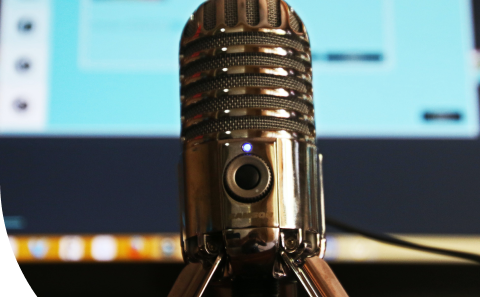
Are you a global marketing professional with stories to share?
Popular Posts
Popular industry news, interviews, technologies, and resources.
